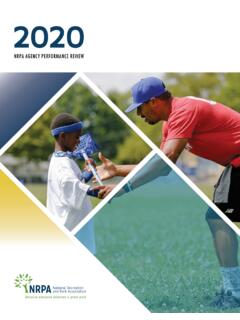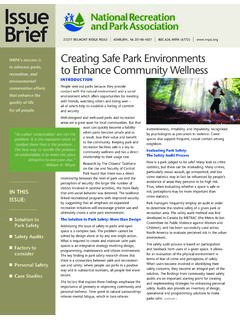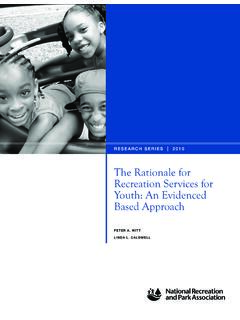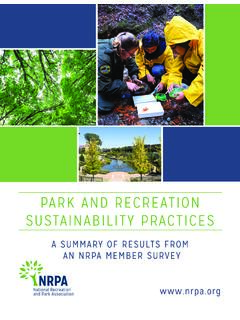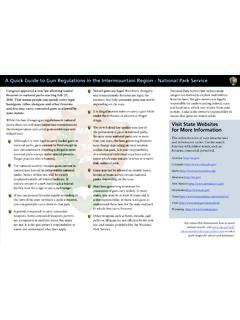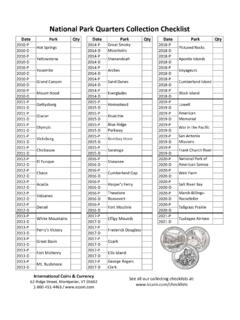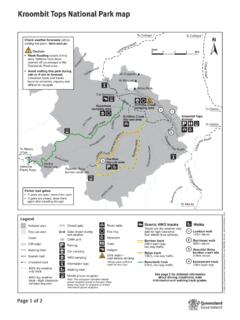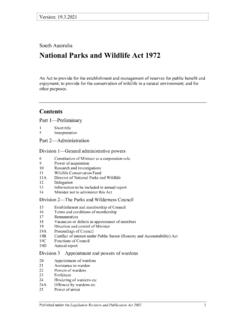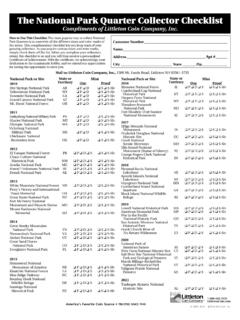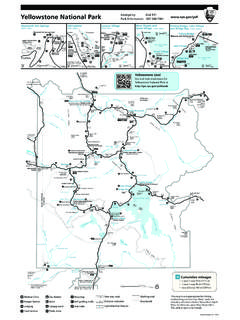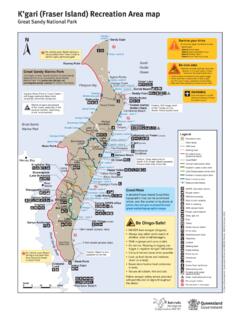Transcription of Parks & Recreation in Underserved Areas
1 Parks & Recreation in Underserved Areas A Public Health PerspectiveParks & Recreation in Underserved Areas : A Public Health Perspective iExecutive Summary ..iiIntroduction ..1 Part IDisparities in Distribution of and Access to Public Parks and Recreation : The Influence on park Use and Physical Activity ..2 Part IIDisparities in park Facilities and park Conditions: Additional Factors that Affect park Use and Physical Activity ..5 Conclusion ..7 Endnotes ..8 ContentsParks and Recreation in Underserved Areas :A Public Health Perspectiveii Parks & Recreation in Underserved Areas : A Public Health Perspectiveur nation is currently facing pressing public health concerns relating to obesity. As a result of sky-rocketing obesity rates, chronic diseases are also on the rise. The dialogue around tackling obesity has shifted from solely focusing on nutrition towards understanding the built environment and its influence on promoting healthy of the several issues in addressing the built environment points to whether there are adequate places to engage in physical activity within communities in the United States.
2 As a result, park and Recreation agencies, who hold an appropriate position in this dialogue, have become key players in improving avenues to encourage physical OParks & Recreation in Underserved Areas : A Public Health Perspective iiiSeveral studies have documented that while Parks and recreational facilities are available throughout the United States, there are several additional factors that affect park use and physical activity levels. This paper examines the following factors: park Access Easy access to Parks is associated with increased park use. park visitation is much more frequent and physical activity levels are much higher for those who live within walking distance to a park . park distribution Disparities in park distribution are particularly evident in Areas with low income and racial/ethnic populations. Higher park acreage within a community is associated with increased participation in physical activity.
3 park Facilities Within Parks , there are certain types of facilities that encourage higher levels of physical activity than others such as trails and playgrounds. park Conditions park facilities that are consistently well maintained, aesthetically appealing and safe are associated with increased public use and physical light of the urgency of the obesity epidemic and available research, it is essential for park and Recreation agencies to review and reevaluate the aspects of Parks that can potentially have a lasting impact on the future of public health. 1 Parks & Recreation in Underserved Areas : A Public Health PerspectivePublic health concerns over physical inactivity in the United States have sparked an interest in the role that public Parks and Recreation play in promoting healthy lifestyles. Over the last two decades, obesity rates for adults and children have increased steadily1. The Centers for Disease Control and Prevention (CDC) reports that in 2010, none of the states had an obesity prevalence of less than 20% and twelve states had a prevalence of over 30%1.
4 African Americans experience the highest rates of obesity at followed by Hispanics at and Caucasians at Research shows that although lowering daily calorie intake accounts for most weight loss, the only approach to consistently maintaining weight loss is by engaging in the recom-mended levels of physical activity3. Numerous empirical studies have investigated the association between green space, Parks and physical activity behavior. A majority of these studies reveal evidence of positive correlations between park access, park use and physical activity levels4. Consequently, the availability of park and Recreation resources and easy, safe access to them is a promising avenue to encourage increased levels of physical activity in all people. While public Parks and recreational facilities are a common amenity throughout several communities, park distribution, park access, park attributes, park conditions and park use varies across different populations and communities5.
5 Studies have highlighted that unequal distribution of and access to green spaces, Parks and Recreation do indeed exist and that physical activity levels and park use are dependent on demographic, socioeconomic (SES) and regional characteristics6,7,8,9. Furthermore, availability of park facilities and the conditions of the facilities also determines the frequency of park use and physical activity levels10. Parks provide health, social and economic benefits in an environmental context; therefore, they are considered environmental amenities and the current dialogue on disparities in park proximity, park facilities and facility conditions is framed in the context of an environmental and social justice paper takes a closer look at how park use and physical activity levels are influenced by the following factors: distribution and access to public Parks and Recreation , park facilities and park conditions. INTRODUCTION Parks & Recreation in Underserved Areas : A Public Health Perspective 2 IntroductionPark proximity plays an important role in promoting higher levels of park use and physical activity amongst diverse populations, particularly for youth4.
6 A study examining park proximity and travel diary data of youth between the ages of five and twenty in Atlanta, GA illustrates that youth who resided close to Parks and open space were approximately two to three times likely to take a walk within a two-day period than their counterparts that had no Parks near their homes11. This holds true for adults as well people who reside within half a mile of a park exercise five or more times a week than those who reside further away from parks12. Interestingly, the number of Parks and Recreation facilities established within a community is also associated with increased physical activity levels13,14. A study conducted in West Virginia revealed that the total number of Recreation facilities, publically managed county acres and county acres reserved for water-based Recreation was associated with physical activity levels. The study found that counties that had the largest acreage of recreational space had more people meeting the recommended levels of physical IDisparities in Distribution of and Access to Public Parks and Recreational Activities: The Influence on park Use and Physical Activity park proximity plays an important role in facilitating higher levels of park use and physical activity levels particularly amongst youth public Parks and Recreation is available in urban, suburban and rural communities across the United States, the distribution of these amenities is not uniform.
7 Disparities in distribution and park access exist across communities that are specifically characterized by low-income populations and some racial/ethnic minority populations15,16. This is documented as one of the several aspects of the built environment that affects the ability for low income and racial/ethnic minorities to meet the daily recommended levels of physical suggests that there are no significant differences in the number of pay-per-use recreational facilities for low, medium and high SES communities; however, there are notably fewer publically-provided resources such as Parks , trails, and playgrounds in low and medium SES communities than in high SES communities17. A nationally representative study of American youth found that the distribution of public Parks and recre-ational facilities was disproportionate such that non-White and low income neighborhoods were fifty percent less likely to have one recreational facility in their community than White and high income neighbourhoods8.
8 While some metro-based studies have demonstrated that low income and minority populations have greater access to public Parks , public pools and green space, national -based studies show evidence that access to the same amenities is much lower in neighborhoods largely occupied by African Americans8,18. The national guideline on sufficient distribution of parkland ranges from 6 acres to 19 acres per 1,000 of the population19,20, however, in Los Angeles, CA it is reported for Areas that had a population of 75% or more Latinos, there was acres of parkland available per 1,000 residents. Areas that had the same percentage or more African Americans had acres of parkland per 1,000 residents and Areas that had 75% or more non-Hispanic Whites had acres of parkland per 1,000 residents thus illustrating that the acreage of parkland available to Latinos and African Americans falls significantly below the national average21. A study conducted in Baltimore, MD found that although African Americans had easier access to Parks than Whites (within a 400 meter walking distance or less), Whites had access to more parkland within walking distance than did African Americans.
9 This resulted in high park congestion in predominantly African American neigh-borhoods20. Research reports that creating spaces for physical activity has resulted in a 26% increase in the number of people that exercised at least three times a week. There are several communities in the United States that are involved in initiatives to promote easy access to Parks and Recreation . 3 Parks & Recreation in Underserved Areas : A Public Health PerspectiveStimulating Economic ActivityDisparities in park distribution and park access exist across communities particularly in neighborhoods that largely consist of low income and racial/ethnic populations 15,16,17. The City Project: Los Angeles State Historic park The City Project based in California, an organization whose mission to achieve equal justice for all, was a leader in the alliance towards building the Los Angeles State Historic Park22. The 32 acre park is located in downtown Los Angeles in the Chinatown Cornfield.
10 Prior to the establishment of the park , residents of Chinatown and The William Mead Housing Project did not have a park in their neighborhood. The park now serves 282,967 children who live within a five mile radius of the Cornfield, a community that is primarily Latino and Asian and a community of which approximate-ly one-third of the population lives in poverty22. Parks & Recreation in Underserved Areas : A Public Health Perspective 4 Stimulating Economic ActivityMiami Dade Open Space Master Plan: A Sustainable System of Parks Miami Dade County is facing population growth that is expected to result in an increase of auto-mobile trips by 39% in addition to other challenges that are associated with population increases23. In response to the changing environment, the county developed the Miami Dade Open Space Master Plan to address these issues. Two of the several guiding principles of the master plan are access and equity to Parks and other amenities.
